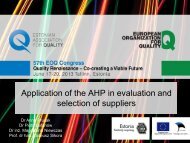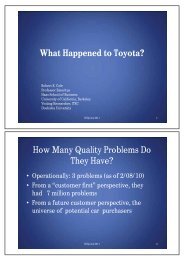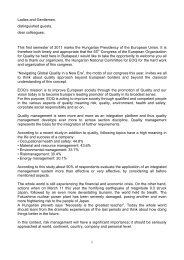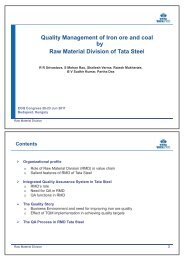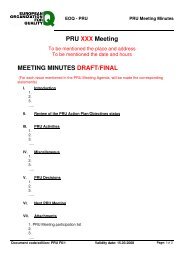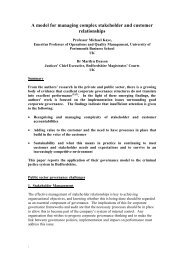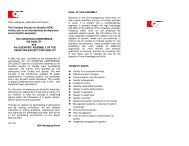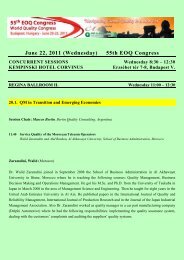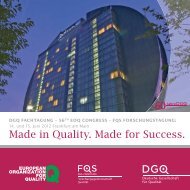Improving Quality Management in Higher Education ... - EOQ
Improving Quality Management in Higher Education ... - EOQ
Improving Quality Management in Higher Education ... - EOQ
You also want an ePaper? Increase the reach of your titles
YUMPU automatically turns print PDFs into web optimized ePapers that Google loves.
<strong>Improv<strong>in</strong>g</strong> <strong>Quality</strong> <strong>Management</strong> <strong>in</strong><br />
<strong>Higher</strong> <strong>Education</strong> Institution (HEI):<br />
a case study of us<strong>in</strong>g EFQM<br />
Excellence Model <strong>in</strong> Estonian <strong>Higher</strong><br />
<strong>Education</strong> Institution<br />
Anneli Lorenz<br />
Project Manager 2008-2012
GOLAS OF THE QUALITY PROCESS<br />
Internal quality management system;<br />
strengths and areas for improvement;<br />
best practices;<br />
accreditation process;<br />
<strong>in</strong>crease the competitiveness of Estonian<br />
<strong>in</strong>stitutions of higher education and support their<br />
success <strong>in</strong> the European Union and worldwide.
MORE ABOUT PROCESS<br />
• From 2009 to 2012 (three processes – 2009/10,<br />
2010/11, 2011/12);<br />
• 17 universities and Federation of Estonian<br />
Students Unions (EÜL)<br />
• more than 300 people are tra<strong>in</strong>ed <strong>in</strong> quality.
QUALITY MODEL THAT WAS USED<br />
European excellence award model and<br />
scor<strong>in</strong>g matrix (EFQM Excellence<br />
Award, EFQM-European Foundation for<br />
<strong>Quality</strong> <strong>Management</strong>).
The EFQM Excellence Model
STEPS OF PROCESS<br />
Selection of organisations<br />
Tra<strong>in</strong><strong>in</strong>g of representatives of organisations<br />
Submission of organisations' self-analysis documents<br />
Tra<strong>in</strong><strong>in</strong>g of assessors<br />
Visit of organisations by assessors<br />
Compil<strong>in</strong>g and submission of feedback documents to organisations<br />
Feedback tra<strong>in</strong><strong>in</strong>g for organisations<br />
Assessors' follow-up visits to organisations<br />
Conduct<strong>in</strong>g a feedback survey and analysis of results<br />
F<strong>in</strong>al sem<strong>in</strong>ar/conference
Where were we 2009-2012<br />
RESULTS
MAIN OBSERVATION<br />
(based on the assessment criteria):<br />
LEADERSHIP<br />
• Responsibility at all levels of management are not<br />
clearly def<strong>in</strong>ed;<br />
•how to motivate managers to deal with the quality
POLICY AND STRATEGY<br />
Development plans and strategies require<br />
clearer objective of adopt<strong>in</strong>g, review<strong>in</strong>g,<br />
measur<strong>in</strong>g and mak<strong>in</strong>g of the improvements.
EMPLOYEES<br />
• Development discussion - planned, but<br />
implementation depends on the middle managers;<br />
• participation <strong>in</strong> the tra<strong>in</strong><strong>in</strong>g/courses - there are no<br />
l<strong>in</strong>ks between tra<strong>in</strong><strong>in</strong>g/courses and organizational<br />
choices;<br />
•career opportunities - opportunities exist <strong>in</strong> all<br />
<strong>in</strong>stitutions of higher education;<br />
•employee motivation process - works if the<br />
employees also participate <strong>in</strong> the process.
PARTNERSHIPS AND RESOURCES<br />
• A choice of partners based on historical<br />
tradition and personal relationships;<br />
• search<strong>in</strong>g for partners but their f<strong>in</strong>d<strong>in</strong>g is not<br />
determ<strong>in</strong>ed by clear targets;<br />
• analysis and assessment of cooperation with<br />
external partners;<br />
• the need to <strong>in</strong>crease the focus on<br />
<strong>in</strong>ternationalisation and to set relevant<br />
targets.
PROCESSES<br />
• Question about systematic management;<br />
• importance of support processes.
STAKEHOLDER RESULTS<br />
• Stakeholder specification;<br />
• students feedback doesn`t have targets, trends<br />
and comparisons;<br />
• student mobility;<br />
• the results are not comparable.
EMPLOYEE RESULTS<br />
• satisfaction of employees;<br />
• <strong>in</strong>dicators - participation <strong>in</strong> research<br />
conferences, the number of publications,<br />
the distribution of qualifications, offices<br />
and ages, the length of employment.
SOCIETY RESULTS<br />
• Area of improvement is the weakness <strong>in</strong><br />
measur<strong>in</strong>g the effectiveness of goals.
HEI’s PERFORMANCE INDICATORS<br />
• Results are, but goals should be more<br />
accurate;<br />
• risk management – impotant;
VALUES OF THE PROCESS<br />
• The top management <strong>in</strong> quality;<br />
• development of quality systems <strong>in</strong> HEI;<br />
• quality awareness and systems <strong>in</strong> HEI;<br />
• the ability to show and analyse the aspects<br />
that ensure quality <strong>in</strong> the HEI;<br />
• ensur<strong>in</strong>g the compliance of <strong>in</strong>dicators with the<br />
priorities of the HEI;<br />
• higher <strong>in</strong>vestment <strong>in</strong> employees.
Thank you!<br />
Questions<br />
anneli.lorenz@emu.ee




